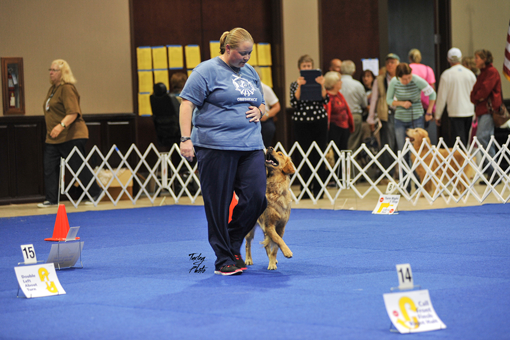Mastering Master Rally Signs: Tips for Success
When you and your dog reach the Master level of rally, you'll face a whole new challenge: master rally signs. These signs go beyond the basics of sit, down, and heeling. They ask for precision, teamwork, and independence all at once. For many teams, this level is where rally really gets exciting—but it can also feel a bit intimidating. The good news is that with the right training plan, you and your dog can tackle these signs with confidence and even have a lot of fun along the way.
What Makes Master Rally Signs Tricky?
Master-level signs often combine multiple elements—things like distance, handler motion, or signals—into one exercise. Unlike the earlier levels, where the signs are more straightforward, master rally signs really test how clearly you can communicate and how well your dog can stay engaged. Here are a few of the common challenges I see:
- Dogs guessing and moving before the cue instead of waiting
- Wide or sloppy spins and pivots
- Trouble switching between energetic moves and still, precise behaviors
- Losing focus partway through a longer, more complex course
These challenges are normal, but they don't have to hold you back. With systematic training, you can absolutely teach these skills—and your dog will enjoy learning them.
Spins and Pivots
Spins, turns, and pivots are some of the flashiest master rally signs. They require your dog to stay engaged while moving tightly around you. Dogs often either swing too wide or lose enthusiasm, so good mechanics are key.
Tips for Spins and Pivots:
- Start with a hand target or treat lure to help your dog understand the movement.
- Reward often in the beginning so your dog builds confidence and stays motivated.
- Work both directions evenly—most dogs have a "strong side" and a "weaker side."
- Once your dog understands the spin, add your own handler movement so they learn to stay connected.
- Mix in some quick "spin-for-a-cookie" games to keep the energy up.
Trainer tip: I like to warm up with a spin at the start of practice. It's a fun way to get my dogs' brains and bodies engaged before we move on to precision work.
Moving Stands
The moving stand is one of those signs that really shows whether your dog understands what you're asking. They need to stop in place while you keep walking—a tough skill if they're used to automatically sitting or lying down.
Tips for Moving Stands:
- First, make sure you have a solid stand from a stop. Reinforce this a lot.
- Add just a step or two of forward motion before asking for the stand.
- Mark and reward right away so your dog knows that freezing in place is correct.
- Slowly add more movement and start circling your dog before releasing them.
- Once it's solid, practice with distractions so your dog learns to hold the behavior confidently.
Send Exercises
Send signs—like sending your dog to a cone or over a jump—require a lot of independence and trust. They're some of the most exciting signs to perform, but they can also feel stressful if your dog prefers to stay close.
Tips for Send Exercises:
- Build a ton of value for the cone, jump, or target by rewarding right at the destination.
- Start with short distances and only add more when your dog is confident.
- Use consistent cues—both your voice and your body language—to set your dog up for success.
- Practice in different settings so your dog doesn't think the behavior only happens in one place.
- Keep it playful! Sends should always feel like a game.
Trainer tip: I'll often set up a cone in my living room and practice quick sends indoors. It's a low-pressure way to build confidence before trying longer sends outside.
Signals and Distance Work
Signals become even more important at this level. Your dog needs to respond to non-verbal cues, sometimes at a distance, and often while holding position. It's a challenge, but once your dog understands, it's incredibly rewarding.
Tips for Signals:
- Start close and give your hand signal first, followed by your verbal cue.
- Gradually increase distance—literally one step at a time.
- Separate your verbal cues from signals so your dog doesn't get dependent on one or the other.
- Reward generously when your dog gets it right from farther away. Rewarding from behind is a helpful way to keep your dog out away from you.
- If your dog struggles, move back in and rebuild confidence.
Trainer tip: One of my favorite ways to practice this is to cue a sit or down from across the room before mealtime. The dogs catch on quickly because the reinforcement (their dinner!) is strong and immediate.
Keeping Precision and Joy Together
The biggest secret to mastering master rally signs is balancing accuracy with joy. Precision without enthusiasm makes for a flat performance, but too much energy can get sloppy. The solution is to keep training sessions short, upbeat, and well-rewarded. Celebrate the little wins—like a tight pivot or a confident send—and your dog will love the process as much as you do.
Practical tip: Rotate between fun, high-energy games (like tug or spins) and precise work (like fronts or finishes) within a session. This helps your dog learn to shift gears smoothly, which is exactly what they'll need in the ring. Don't do too many reps of any one thing!
Final Thoughts
Master rally signs highlight the teamwork and communication you've built with your dog. While they might look intimidating at first, every one of them can be broken down into smaller, teachable steps. With patience, generous rewards, and consistent practice, these signs will become second nature. And when that happens, you'll find yourself enjoying the Master class even more—it's where rally really shines.
By accepting you will be accessing a service provided by a third-party external to https://www.fenzidogsportsacademy.com/
